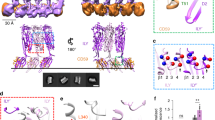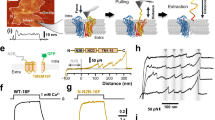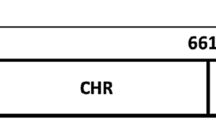Abstract
Cholesterol-dependent cytolysins are bacterial protein toxins that bind to cholesterol-containing membranes, form oligomeric complexes and insert into the bilayer to create large aqueous pores. Membrane-dependent structural rearrangements required to initiate the oligomerization of perfringolysin O monomers have been identified, as have the monomer-monomer interaction surfaces, using site-specific mutagenesis, disulfide trapping and multiple fluorescence techniques. Upon binding to the membrane, a structural element in perfringolysin O moves to expose the edge of a previously hidden β-strand that forms the monomer-monomer interface and is required for oligomer assembly. The β-strands that form the interface each contain a single aromatic residue, and these aromatics appear to stack, thereby aligning the transmembrane β-hairpins of adjacent monomers in the proper register for insertion. Collectively, these data reveal a novel membrane binding–dependent mechanism for regulating cytolysin monomer-monomer association and pore formation.
This is a preview of subscription content, access via your institution
Access options
Subscribe to this journal
Receive 12 print issues and online access
$189.00 per year
only $15.75 per issue
Buy this article
- Purchase on Springer Link
- Instant access to full article PDF
Prices may be subject to local taxes which are calculated during checkout








Similar content being viewed by others
References
Alouf, J.E. Introduction to the family of the structurally related cholesterol-binding cytolysins ('sulfhydryl-activated' toxins). In The Comprehensive Sourcebook of Bacterial Protein Toxins (eds. Alouf, J.E. & Freer, J.H.) 443–456 (Academic, London, 1999).
Tweten, R.K., Parker, M.W. & Johnson, A.E. The cholesterol-dependent cytolysins. Curr. Top. Microbiol. Immunol. 257, 15–33 (2001).
Olofsson, A., Hebert, H. & Thelestam, M. The projection structure of perfringolysin O (Clostridium perfringens Θ-toxin). FEBS Lett. 319, 125–127 (1993).
Rossjohn, J., Feil, S.C., Mckinstry, W.J., Tweten, R.K. & Parker, M.W. Structure of a cholesterol-binding, thiol-activated cytolysin and a model of its membrane form. Cell 89, 685–692 (1997).
Heuck, A.P., Tweten, R.K. & Johnson, A.E. β-barrel pore forming toxins: intriguing dimorphic proteins. Biochemistry 40, 9065–9073 (2001).
Heuck, A.P. & Johnson, A.E. Pore-forming protein structure analysis in membranes using MIFT, multiple independent fluorescence techniques. Cell Biochem. Biophys. 36, 89–102 (2002).
Shepard, L.A. et al. Identification of a membrane-spanning domain of the thiol-activated pore-forming toxin Clostridium perfringens perfringolysin O: an α-helical to β-sheet transition identified by fluorescence spectroscopy. Biochemistry 37, 14563–14574 (1998).
Shatursky, O. et al. The mechanism of membrane insertion for a cholesterol-dependent cytolysin: a novel paradigm for pore-forming toxins. Cell 99, 293–299 (1999).
Heuck, A.P., Hotze, E.M., Tweten, R.K. & Johnson, A.E. Mechanism of membrane insertion of a multimeric β-barrel protein: Perfringolysin O creates a pore using ordered and coupled conformational changes. Mol. Cell 6, 1233–1242 (2000).
Ramachandran, R., Heuck, A.P., Tweten, R.K. & Johnson, A.E. Structural insights into the membrane-anchoring mechanism of a cholesterol-dependent cytolysin. Nat. Struct. Biol. 9, 823–827 (2002).
Shepard, L.A., Shatursky, O., Johnson, A.E. & Tweten, R.K. The mechanism of pore assembly for a cholesterol-dependent cytolysin: formation of a large prepore complex precedes the insertion of the transmembrane β-hairpins. Biochemistry 39, 10284–10293 (2000).
Hotze, E.M. et al. Arresting pore formation of a cholesterol-dependent cytolysin by disulfide trapping synchronizes the insertion of the transmembrane β-sheet from a prepore intermediate. J. Biol. Chem. 276, 8261–8268 (2001).
Hotze, E.M. et al. Monomer-monomer interactions drive the prepore to pore conversion of a β -barrel-forming cholesterol-dependent cytolysin. J. Biol. Chem. 277, 11597–11605 (2002).
Heuck, A.P., Tweten, R.K. & Johnson, A.E. Assembly and topography of the prepore complex in cholesterol-dependent cytolysins. J. Biol. Chem. 278, 31218–31225 (2003).
Crowley, K.S., Reinhart, G.D. & Johnson, A.E. The signal sequence moves through a ribosomal tunnel into a noncytoplasmic aqueous environment at the ER membrane early in translocation. Cell 73, 1101–1115 (1993).
Lehrer, S.S. Intramolecular pyrene excimer fluorescence: a probe of proximity and protein conformational change. Methods Enzymol. 278, 286–295 (1997).
Gazit, E. A possible role for π-stacking in the self-assembly of amyloid fibrils. FASEB J. 16, 77–83 (2002).
Richardson, J.S. & Richardson, D.C. Natural β-sheet proteins use negative design to avoid edge-to-edge aggregation. Proc. Natl. Acad. Sci. USA 99, 2754–2759 (2002).
Kraulis, P.J. MOLSCRIPT: A program to produce both detailed and schematic plots of protein structures. J. Appl. Crystallogr. 24, 946–950 (1991).
Merritt, E.A. & Bacon, D.J. Raster3D photorealistic molecular graphics. Methods Enzymol. 277, 505–524 (1997).
Acknowledgements
This work was supported by US National Institutes of Health grant AI 37657 and the Robert A. Welch Foundation.
Author information
Authors and Affiliations
Corresponding author
Ethics declarations
Competing interests
The authors declare no competing financial interests.
Rights and permissions
About this article
Cite this article
Ramachandran, R., Tweten, R. & Johnson, A. Membrane-dependent conformational changes initiate cholesterol-dependent cytolysin oligomerization and intersubunit β-strand alignment. Nat Struct Mol Biol 11, 697–705 (2004). https://doi.org/10.1038/nsmb793
Received:
Accepted:
Published:
Issue Date:
DOI: https://doi.org/10.1038/nsmb793
This article is cited by
-
Visualizing the Domino-Like Prepore-to-Pore Transition of Streptolysin O by High-Speed AFM
The Journal of Membrane Biology (2023)
-
Reprogramming cholesterol metabolism in macrophages and its role in host defense against cholesterol-dependent cytolysins
Cellular & Molecular Immunology (2022)
-
Single-molecule kinetics of pore assembly by the membrane attack complex
Nature Communications (2019)
-
Inerolysin and vaginolysin, the cytolysins implicated in vaginal dysbiosis, differently impair molecular integrity of phospholipid membranes
Scientific Reports (2019)
-
Glycointeractions in bacterial pathogenesis
Nature Reviews Microbiology (2018)



